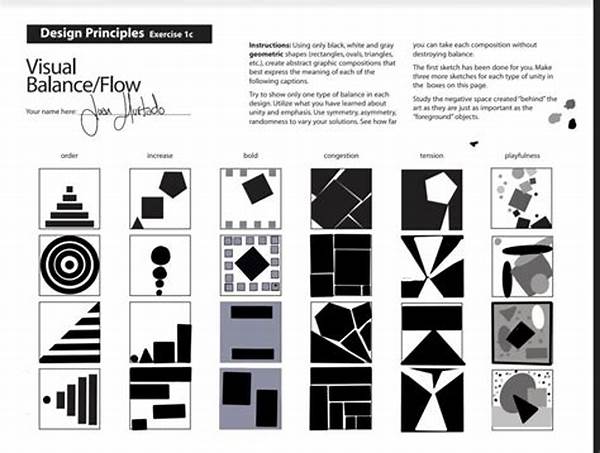Hey there, design enthusiasts! Today we’re tackling a concept that might sound a bit like a philosophy lesson but is key to nailing those killer designs: visual equilibrium. Balancing elements in design is as intuitive as riding a bike, once you get the hang of it. Let’s dive in!
Read Now : Best Methods For Backing Photos
Why Visual Equilibrium is Essential
When we talk about designing with visual equilibrium, we’re chatting about balance, harmony, and making things feel just right. Imagine opening a webpage and feeling instantly calm and interested, rather than overwhelmed or bored. That’s the magic of equilibrium!
So, why should you care? Well, when designs are balanced, your content shines without distractions. Think about the last time you saw a cluttered website — did you stick around? Probably not. By designing with visual equilibrium, you ensure that viewers are drawn to your message, not running for the back button. It’s all about creating a welcoming space where the eye moves naturally from one element to the next. Whether you’re into minimalism or a more ornate style, balance is your best friend.
Visual equilibrium isn’t about making everything symmetrical or cookie-cutter perfect. It’s an art form that lets you play with proportion, color, and placement – creating a dance of elements that guides perception and engagement. So, next time you’re working on a project, picture yourself juggling. Keep those elements in sync while showcasing your unique style!
Quick Tips for Visual Balance
1. Center of Attention: Design around a focal point using visual equilibrium techniques.
2. Color Harmony: Achieve vibrancy with balance by considering color equilibrium.
3. Symmetry Play: Experiment with asymmetry in visual equilibrium design.
4. Proportion Powers: Use size balance to impact design aesthetics.
5. White Space Wisdom: Keep designs breathable with balanced white space.
Crafting Aesthetics with Balance
Jumping into the world of designing with visual equilibrium might feel like entering a new realm at first. It’s a bit of a blend between art and science, where you get to play around with different elements like color, shape, and space. When you achieve that perfect balance, your design won’t just look great; it’ll feel right to anyone who lays eyes on it.
Start by identifying what you want your audience to focus on. This could be a product, a photograph, or an important piece of information. Use visual equilibrium to direct attention to these focal points – think of it as the GPS for your viewer’s eyes. Experiment with your elements’ placement, shifting them around until they create that satisfying balance you’re aiming for. Don’t be afraid of white space; it’s not wasted space, but rather, the key to highlighting your primary elements.
Mastering the Art of Equilibrium
1. Your design journey starts with understanding your main elements. Designing with visual equilibrium helps you highlight these.
2. Play with space. Balance doesn’t mean symmetry!
3. Get creative with colors. Equilibrium comes from complementing shades, not clashing ones.
4. Texture matters! Mixing textures can create harmony.
Read Now : Quick Photo Editing Techniques
5. Typography choice can make or break visual equilibrium.
6. Never underestimate the power of alignment. Center or edge it out!
7. Size things up. Bigger isn’t always better; balance it.
8. Consider the flow. Take viewers on a seamless journey through your design.
9. Keep refining. Designing with visual equilibrium takes practice.
10. Trust your instincts. If it feels balanced, it probably is!
Exploring Modern Trends
Let’s delve into some modern trends when designing with visual equilibrium. You might notice a lot of designs today favoring minimalism and clean lines, but there’s also a resurgence of bold, eye-catching color palettes. The key to integrating these trends is balance. Minimalist designs naturally play well with equilibrium. The simplicity allows for elements to shine without competing against each other. The trick lies in maintaining interest, usually done through strategic placement and intelligent use of white space.
On the flip side, if you’re leaning towards bolder, more vibrant designs, visual equilibrium acts like your best roadmap. Bright colors and daring patterns need careful balancing to prevent them from overwhelming viewers. By focusing on a central element and creating harmony through complementary colors and contrasting lines, you ensure that your bold designs remain inviting rather than chaotic. Remember, the ultimate goal is to make your designs as engaging as they are pleasing to the eye, ensuring viewers resonate with your work throughout their journey across your visuals.
Incorporating Slang in Design Chats
Alright, fam! Let’s keep it real about designing with visual equilibrium. It’s about vibing with what feels right. When you’re tossing elements around your canvas, it’s not just about slapping things on there, hoping they stick. Nah, you gotta finesse it. Think of it like this – your design is your canvas, and you’re DJ-ing the beats! It’s gotta flow so smoothly that your viewers can’t help but vibe along with it.
Peep this: each time you add a new element, make sure it’s dancing well with the others, ya know? It’s like your design squad out there doing synchronized moves, each piece complementing the other perfectly. That’s visual equilibrium for ya! When you hit that sweet spot where everything’s in balance, your audience will feel it. It’ll be like watching their favorite song come to life visually – full of energy, rhythm, and harmony. Keep those vibes fresh, and balance every element like a boss!
Wrap-up on Visual Harmony
In a nutshell, designing with visual equilibrium is all about creating harmony where every element contributes to the overall experience, much like an orchestra. Each instrument plays a role, balancing each other out to produce a beautiful symphony. Your design elements should resonate with each other in the same way. Just as no piece of the orchestra can sound discordant, no element in your design should feel out of place.
As you refine your skills in designing with visual equilibrium, remember: practice makes perfect. Start by recognizing imbalances and shifting those elements into coherence. Keep your design goals in mind and align your elements to guide your viewer effortlessly through the visual message you’re crafting. With balance at the forefront, you will not only create sophisticated designs but also communicate your ideas creatively and effectively. Keep experimenting, and before you know it, achieving visual equilibrium will become second nature.



